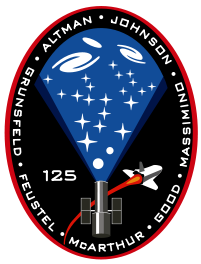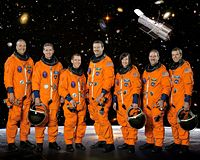STS-125
| STS-125 | |||||
Mission insignia |
|||||
| Mission statistics | |||||
|---|---|---|---|---|---|
| Mission name | STS-125 | ||||
| Space Shuttle | Atlantis | ||||
| Launch pad | LC-39A | ||||
| Launch date | NET May 12 2009, approx. 1:11 p.m. EDT (1711 UTC)[1][2][3] | ||||
| Landing | May 23, 2009, approx. 9:48 a.m. EDT (13:48 UTC) | ||||
| Mission duration | 11 days | ||||
| Number of orbits | TBD | ||||
| Orbital altitude | 320 nautical miles (570 km) | ||||
| Orbital inclination | 28.5 degrees | ||||
Crew photo From left to right : Massimino, Good, Johnson, Altman, McArthur, Grunsfeld and Feustel |
|||||
| Related missions | |||||
|
|||||
STS-125, or HST-SM4 (Hubble Space Telescope Servicing Mission 4) is a planned space shuttle mission scheduled to be the fifth and final servicing mission to the Hubble Space Telescope (HST). The mission will be flown by Space Shuttle Atlantis, with another shuttle ready to launch in case a rescue mission is needed. Due to an anomaly aboard the telescope that occurred on September 27, 2008, STS-125 has been delayed until at least May 2009 to prepare a second data handling unit replacement for the telescope.[1][4][5]
Atlantis will carry two new instruments to the HST, a replacement Fine Guidance Sensor, and six new gyroscopes and batteries to allow the telescope to continue to function at least through 2013. The crew will also install a new thermal blanket layer to provide improved insulation, and a "soft-capture mechanism" to aid in the safe de-orbiting of the spacecraft by an unmanned spacecraft at the end of its operational lifespan.
The mission will be the thirtieth flight of Space Shuttle Atlantis, and the last planned manned mission to the space telescope.[6] The mission will be the first flight of Atlantis since STS-122, and the first flight of Atlantis not to visit a space station since STS-66 in 1994. It will be the first shuttle mission not related to the International Space Station since STS-107, which ended in the Columbia accident.
Due to the difference between the orbit of the International Space Station, and that of the HST, Atlantis will be unable to reach the safe haven of the ISS in the event of its heat shield becoming damaged upon launch. Therefore the mission will require another shuttle to be ready on launch pad 39B for immediate flight on the STS-401 Launch On Need (LON) rescue mission throughout Atlantis' mission.
Contents |
Crew
- Scott D. Altman (4) - Commander
- Gregory C. Johnson (1) - Pilot
- Michael T. Good (1) - Mission Specialist 1
- K. Megan McArthur (1) - Mission Specialist 2
- John M. Grunsfeld (5) - Mission Specialist 3
- Michael J. Massimino (2) - Mission Specialist 4
- Andrew J. Feustel (1) - Mission Specialist 5
Number in parentheses indicates number of spaceflights by each individual prior to and including this mission.
Crew notes
The crew of STS-125 includes three astronauts who have previous experience with servicing Hubble.[7][8] Altman visited Hubble as commander of STS-109, the fourth Hubble servicing mission, in 2002. Grunsfeld, an astronomer, has serviced Hubble twice, performing a total of five spacewalks on STS-103 in 1999, and STS-109. Massimino served with both Altman and Grunsfeld on STS-109, and performed two spacewalks to service the telescope.
Mission parameters
- Mass: TBD
- Perigee: 486 km
- Apogee: 578 km
- Inclination: 28.5°
- Period: 97 min
Mission payloads
STS-125 will carry the "Soft-Capture Mechanism" and install it onto the telescope.[9] This will enable a spacecraft to be sent to the telescope to assist in its safe de-orbit at the end of its life. It is a circular mechanism containing structures and targets to aid docking.[7]
The mission will add two new instruments to Hubble. The first instrument, the Cosmic Origins Spectrograph, will be the most sensitive ultraviolet spectrograph installed on the telescope.[10][7] Its far-UV channel will be 30 times more sensitive than previous instruments and the near-UV will be twice as sensitive. The second instrument, the Wide Field Camera 3, is a panchromatic wide-field camera that can record a wide range of wavelengths, including infrared, visible, and ultraviolet light.[7]
The infrastructure of the telescope will be maintained and upgraded by replacing a "Fine Guidance Sensor" that controls the telescope's directional system, installing a set of six new gyroscopes, replacing batteries, and installing a new outer blanket layer to provide improved insulation.[7]
The payload bay elements are the Super Lightweight Interchangeable Carrier (SLIC) holding the Wide Field Camera 3, new batteries, and a radiator; the ORU Carrier with the Cosmic Origins Spectrograph and FGS-3R instruments; the Flight Support Structure (FSS) for holding the Hubble during repairs; and the Multi-Use Lightweight Equipment Carrier (MULE) holding support equipment.
Mission background

STS-125 was originally assigned to Space Shuttle Discovery, with a launch date no earlier than May 2008.[11] This would have moved the mission ahead of STS-119, ISS Assembly flight 15A. STS-125 will be the first visit to the Hubble Space Telescope for Atlantis; the telescope has been previously serviced twice by Discovery, and once each by Columbia and Endeavour.
STS-125 was further delayed to October 2008 due to manufacturing delays on external tanks for future space shuttle missions. Lockheed Martin experienced delays during the production changes to make new external tanks with all the enhancements recommended by the Columbia Accident Investigation Board, making it impossible for them to produce two tanks for the STS-125 mission—one for Atlantis, and one for Endeavour for an emergency rescue mission, if necessary—in time for the original August launch date.[12]
STS-125 was originally scheduled to be ISS assembly mission ISS-1J. The mission would have delivered the Kibo Japanese Experiment Module (JEM) and JEM's specialized Remote Manipulator System to the station. Columbia was originally planned to fly the fifth Hubble mission, as Columbia was not the optimum orbiter for ISS assembly due to the weight of the orbiter.
IMAX movie
At the end of September, 2007, Warner Bros. Pictures and IMAX Corporation announced that in cooperation with NASA, an IMAX 3D camera will travel to the Hubble telescope in the payload bay of Atlantis for production of a new film that will chronicle the story of the Hubble telescope.[10] IMAX has made a number of movies centered around space, including Destiny in Space, The Dream Is Alive, Mission to Mir, Blue Planet, Magnificent Desolation: Walking on the Moon 3D, and the first trip of IMAX to the ISS in 2001, to make Space Station 3D.[10][13]
Shuttle processing

The crew of Atlantis was at Kennedy Space Center for the Crew Equipment Interface Test in early July, 2008. This allowed the STS-125 crew to get familiar with the orbiter and the hardware they will be using during the flight.
On August 22, 2008, after a delay following Tropical Storm Fay, Atlantis was rolled from the Orbiter Processing Facility to the Vehicle Assembly Building, where it was mated to the external fuel tank and solid rocket booster stack. Problems encountered during the mating process, and delays due to Hurricane Hanna delayed rollout to the pad, which is normally done seven days after rollover.[14][15]
The first rollout to Launch Pad 39A occurred on September 4, 2008. Atlantis was rolled back to the Vehicle Assembly Building on October 20.
On October 30, 2008, NASA announced that Atlantis would be removed from its booster rocket stack and sent back to the Orbiter Processing Facility to await a new 2009 launch date.[1] The stack will be turned over to be used on the STS-119 mission instead. Atlantis will get a new tank and set of boosters for the 2009 launch date.
Contingency mission
STS-401 is the flight designation given to the Contingency Shuttle Crew Support mission which would be launched in the event Atlantis becomes disabled during STS-125.[16] To preserve NASA's post-Columbia requirement of having shuttle rescue capability, a second shuttle will be on launch pad 39-B at the time of STS-125's launch. This has imposed a constraint on deactivation and conversion of pad 39B for Ares I flight tests. Due to the inclination and other orbit parameters of Hubble, Atlantis would be unable to use the ISS as a "safe haven" in the event of structural or mechanical failure.[11][17]
NASA has had contingency rescue missions on standby for all nine flights conducted between the fatal Columbia flight and STS-125.
See also
- 2009 in spaceflight
- Space Shuttle program
- List of space shuttle missions
- List of spacewalks and moonwalks
- List of human spaceflights chronologically
References
- ↑ 1.0 1.1 1.2 NASA (2008). "NASA Managers Delay Hubble Servicing Mission". NASA. Retrieved on October 31, 2008.
- ↑ Tariq Malik (2008). "NASA Delays Hubble Shuttle Mission to May 2009". Space.com. Retrieved on October 31, 2008.
- ↑ Justin Ray (2008). "Spaceflight Now worldwide launch schedule". Retrieved on November 24, 2008.
- ↑ Dennis Overbye (2008). "NASA Delays Trip to Repair Hubble Telescope". New York Times. Retrieved on September 29, 2008.
- ↑ Marcia Dunn - Associated Press (2008). "NASA Delays Repair Mission to Hubble Telescope". ABC News. Retrieved on November 14, 2008.
- ↑ NASA (2007). "NASA Completes Two Important Reviews for Upcoming Hubble Mission". NASA. Retrieved on October 16, 2007.
- ↑ 7.0 7.1 7.2 7.3 7.4 NASA (2007). "NASA Approves Mission and Names Crew for Return to Hubble". NASA. Retrieved on October 16, 2007.
- ↑ NASA (2007). "STS-125: Final Shuttle Mission to Hubble Space Telescope". NASA. Retrieved on October 16, 2007.
- ↑ NASA (2008). "The Soft Capture and Rendezvous System". NASA. Retrieved on October 25, 2008.
- ↑ 10.0 10.1 10.2 NASA (2007). "IMAX Camera Returns to Space to Chronicle Hubble Space Telescope". NASA. Retrieved on October 16, 2007.
- ↑ 11.0 11.1 Chris Bergin (2007). "Hubble Servicing Mission moves up". NASASpaceflight.com. Retrieved on October 16, 2007.
- ↑ William Harwood (2008). "Hubble servicing mission's launch date threatened". [CBS News]. Retrieved on March 28, 2008.
- ↑ IMAX (2008). "IMAX - All Films". IMAX Corporation. Retrieved on October 25, 2008.
- ↑ Spaceflight Now.com (2008). "Hurricane Hanna delays shuttle's move to pad". Spaceflight Now.com. Retrieved on September 2, 2008.
- ↑ Frank Moring, Jr. (2008). "Hurricane Chances Postpone Atlantis Rollout". Aviation Week. Retrieved on September 2, 2008.
- ↑ Bergin, Chris (2007-04-15). "NASA sets new launch date targets through to STS-124", NASASpaceflight. Retrieved on 2007-08-21.
- ↑ John Copella (2007). "NASA Evaluates Rescue Options for Hubble Mission". NASASpaceflight.com. Retrieved on October 16, 2007.
External links
- STS-125 HST-SM4 page on NASA.gov
- Up to the minute Mission Status
- Hubble Servicing Mission 4 at ESA/Hubble site
- Hubble Service Mission Four Factsheet
|
|||||||||||
|
|||||||||||||||||
|
|||||||||||||||||||||||||||||